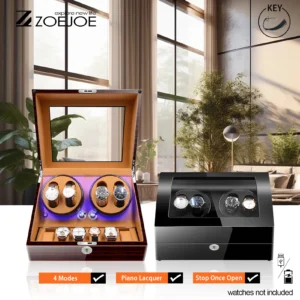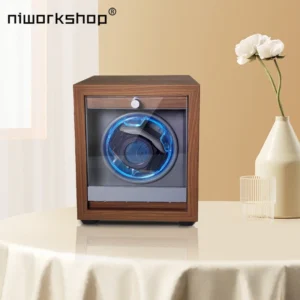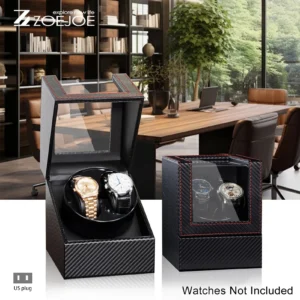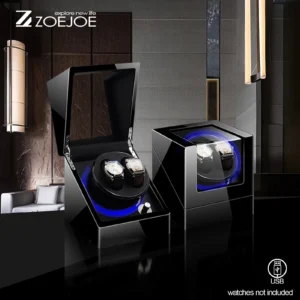Introduction: Why Direction and TPD Matter for Automatic Watches
Automatic watches represent a fascinating blend of traditional craftsmanship and ingenious engineering. Unlike quartz watches that run on batteries, automatic timepieces power themselves through the natural motion of your wrist. Inside these mechanical marvels, a weighted rotor spins as you move, gradually winding the mainspring that stores energy to keep your watch ticking.
But what happens when you’re not wearing your automatic watch? This is where watch winders come in—devices specifically designed to mimic wrist movement, keeping your unworn timepieces running smoothly. However, not all automatic watches wind the same way, which is why two critical settings matter tremendously:
- Direction: Whether the winder rotates clockwise (CW), counter-clockwise (CCW), or both (bi-directional)
- Turns Per Day (TPD): The number of complete rotations a winder makes in 24 hours
Here’s what’s crucial to understand: there is no universal “best” setting that works for all watches. The optimal configuration depends entirely on your specific timepiece and its internal movement type. Using incorrect settings might result in your watch not receiving enough power or experiencing unnecessary wear over time.
Different movement manufacturers—whether ETA, Sellita, or proprietary in-house calibers—design their automatic watch winder programming settings with specific winding mechanisms. Throughout this guide, we’ll explore how to determine and implement the perfect settings for your prized timepieces.
Understanding Turns Per Day (TPD)
TPD, or Turns Per Day, represents the number of complete rotations a watch winder performs within a 24-hour period. This measurement is fundamental to properly maintaining your automatic timepiece when it’s not on your wrist.
TPD Definition: The total number of complete 360° rotations that a watch winder executes in a 24-hour cycle, calibrated to match the winding efficiency needs of specific watch movements.
The concept of TPD directly connects to your watch’s power reserve—the length of time it will run after being fully wound. Most automatic watches have a power reserve ranging from 38 to 42 hours, though some premium models offer extended reserves of 70+ hours. The appropriate TPD setting ensures your watch maintains sufficient power without unnecessary mechanical activity.
Common TPD ranges typically fall between 650-850 rotations per day for most standard automatic movements. For instance, the widely-used ETA 2824 movement generally requires 650-800 TPD for optimal performance. Using a setting within this range provides enough energy to keep the watch running while respecting its mechanical limits.
Many watch owners worry about “overwinding” their timepieces on a winder. Fortunately, modern automatic watches incorporate slip clutch mechanisms (sometimes called “bridle springs”) that prevent overwinding damage. However, incorrect TPD settings can still have consequences:
- Too low TPD: The watch may not receive sufficient winding to maintain accurate timekeeping or might stop completely
- Unnecessarily high TPD: Creates additional wear on the winding mechanism without providing benefits
Finding the right watch winder TPD settings guide for your specific timepiece ensures it remains ready to wear while minimizing unnecessary mechanical stress.
Winding Directions Explained: CW, CCW, and Bi-directional
The direction in which a watch winder rotates plays a crucial role in effectively maintaining your automatic timepiece. Different watch movements are engineered to wind in specific directions, making this setting just as important as TPD.
Watch movements contain a system of gears, pawls, and wheels that transfer rotational energy from the rotor to the mainspring. Depending on the movement’s design, this transfer may only happen in one direction or both:
- Clockwise (CW)
- The winder rotates in a right-hand direction (like traditional clock hands)
- Essential for movements that only wind when the rotor spins clockwise
Common in older watch movements and certain Swiss calibers
Counter-clockwise (CCW)
- The winder rotates in a left-hand direction (opposite of clock hands)
- Required for movements designed to wind only through counter-clockwise rotor motion
Found in select Japanese movements and specialty Swiss calibers
Bi-directional
- The winder alternates between clockwise and counter-clockwise rotation
- Most versatile setting, suitable for watches that wind in either or both directions
- Mimics natural wrist movement and works with most modern automatic watches
The technical reason for these differences lies in the design of the rotor and pawl mechanism. In unidirectional winding systems, tiny pawls engage with teeth only when rotating in the effective direction. In bi-directional systems, a more complex mechanism allows energy capture regardless of rotation direction.
Understanding the ultimate guide automatic watch winder settings can help you visualize how each direction works. When setting direction, remember that positions are typically described with the watch’s 12 o’clock position at the top.
Many modern luxury watches feature bi-directional winding mechanisms, but assuming this without verification could leave your precious timepiece unwound. Brands like Rolex typically use bi-directional movements, while some other manufacturers still produce watches that wind more efficiently in one specific direction.
Selecting the right automatic watch winder with appropriate direction capabilities ensures your timepieces receive proper care when not being worn.
How to Determine the Correct Settings for Your Specific Watch
Finding the optimal winder settings for your automatic watch doesn’t need to be complicated. Here are three reliable methods to determine the correct TPD and direction for your specific timepiece:
1. Consult Manufacturer Documentation
The most accurate source of information is directly from the watch manufacturer:
1. Check your watch’s instruction manual for winding specifications
2. Visit the manufacturer’s official website and search for technical specifications
3. Contact customer service with your exact model and movement information
4. Look for the movement caliber number (usually found on the caseback or in documentation)
Manufacturers often provide precise TPD requirements and winding direction information for their movements. This information may be presented as “rotor winding direction” or “automatic winding system specifications.”
2. Use Online Winder Setting Databases
Several reputable resources compile winding specifications for numerous watch models:
1. WOLF Watch Winder Database
2. Orbita Watch Database
3. Rapport London’s Setting Guide
4. Watch forums with user-compiled databases
When searching these databases, have your watch’s exact model number and movement type ready. Some databases allow searching by brand and model, while others organize by movement caliber.
3. Trial-and-Error Testing Method
When documentation isn’t available, systematic testing can determine the correct settings:
1. Begin with a fully wound watch
2. Start with bi-directional rotation at 650 TPD (a common middle ground)
3. Monitor the watch’s timekeeping over 48 hours
4. Adjust settings based on performance (detailed in the next section)
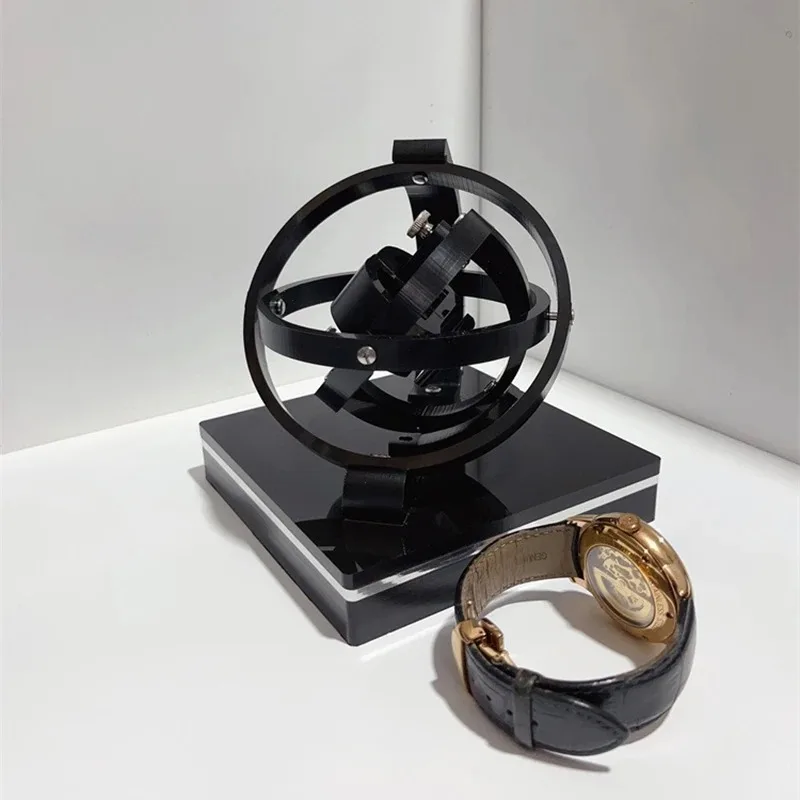
The key to success is patience and methodical adjustment. Proper how program watch winder setup guide information emphasizes the importance of giving each setting configuration enough time to demonstrate effectiveness before making changes.
Remember that settings may vary even between watches from the same manufacturer if they use different movement calibers. Always prioritize model-specific information over general brand recommendations.
The Trial-and-Error Method: Step-by-Step Testing Process
When manufacturer specifications aren’t readily available, this systematic testing approach will help determine the optimal settings for your automatic watch:
Manually wind your watch completely
Start with a fully wound watch to establish a proper baseline. For most watches, this means turning the crown clockwise approximately 20-30 times until you feel resistance.Set the winder to bi-directional rotation at 650 TPD
This middle-ground setting works for many watches and provides a good starting point. Ensure the watch is secure in the winder with the dial facing forward.Monitor accuracy for 48 hours
Place your watch on the winder and check its accuracy against a reliable time source after two full days. Note any time loss or gain.Adjust TPD if necessary
If the watch is losing time or has stopped, increase the TPD setting to 750, then test for another 48 hours. If still problematic, try 850 TPD. Record results at each stage.Test clockwise-only rotation
If bi-directional rotation at various TPD settings doesn’t maintain power, switch to clockwise-only rotation at 650 TPD and repeat the 48-hour test. Increase TPD as needed.Test counter-clockwise rotation
If clockwise rotation proves ineffective, test counter-clockwise rotation at 650 TPD, again increasing as needed after 48-hour monitoring periods.Evaluate results and finalize settings
Once you find a combination that keeps the watch running accurately, use those settings moving forward. If all combinations fail, your watch might need servicing.
Throughout this process, maintain detailed records of each configuration tested and the resulting performance. Note that environmental factors like temperature can affect results, so try to keep testing conditions consistent.
Understanding watch winder rotation modes comparison can help you interpret your results more effectively. The goal is to find the minimum TPD setting in the correct direction that reliably keeps your watch running—this minimizes unnecessary wear while ensuring readiness.
Common Watch Winder Setting Mistakes to Avoid
Even the finest timepieces can suffer from improper winder usage. Here are the most common mistakes watch enthusiasts make with their winders, and how to avoid them:
Using generic settings without research
Many owners simply place their watch on a winder without checking specific requirements. Each movement has unique needs—using default settings might not provide adequate winding or could cause excessive wear over time.Placing fully stopped watches directly on winders
When a watch has completely stopped, it’s best to manually wind it before placing it on a winder. Starting with some power in the mainspring helps the automatic winding mechanism engage more effectively.Setting TPD unnecessarily high
Higher is not better when it comes to TPD. Using 1,200 TPD when your watch only needs 650 creates needless movement. Find the minimum effective TPD to reduce mechanical stress.Ignoring manufacturer recommendations
When a watchmaker specifies winding parameters, these guidelines reflect optimal conditions for their specific movements. Disregarding these specifications risks suboptimal performance.Not periodically checking accuracy
Even with correct initial settings, factors like winder performance, watch condition, or environmental changes can affect results. Regular accuracy checks ensure continued proper functioning.Assuming all watches use identical settings
Different watches—even from the same brand—may require completely different winder settings. Each timepiece should have individually determined parameters.
When troubleshooting common watch winder problems, remember that certain watches have particularly sensitive winding requirements. Perpetual calendars, for instance, should never be allowed to stop completely due to their complex date mechanisms.
Regular monitoring and adjustment of your winder settings helps ensure your automatic watches remain in perfect working order, ready to wear at a moment’s notice.
Key Features to Look for in a Quality Watch Winder
Investing in the right watch winder is essential for preserving the value and functionality of your automatic timepieces. Here are the critical features that distinguish quality winders:
| Feature | Basic Winders | Premium Winders |
|---|---|---|
| TPD Range | Limited (650-800) | Extensive (300-1,600+) |
| Direction Options | Fixed or limited | CW, CCW, bi-directional |
| Programming | Single setting | Customizable per watch |
| Motor Quality | Standard | Japanese or Swiss, ultra-quiet |
| Rest Period Control | None | Programmable intervals |
| Power Options | AC only | AC/battery/USB options |
| Construction | Plastic/synthetic | Hardwood/metal/premium materials |
Essential Features for Optimal Performance:
A truly versatile watch winder should offer fully programmable TPD settings with a wide range—ideally from 300 to 1,200+ rotations per day. This flexibility accommodates virtually any automatic watch movement on the market.
Direction options are equally important. The winder should provide clockwise, counter-clockwise, and bi-directional rotation capabilities that can be programmed independently. For collectors with multiple watches, individual motor control allows different settings for each timepiece.
Quality motors are the heart of any good winder. Premium Japanese or Swiss-made motors operate silently while maintaining precise rotation speeds. This not only provides better winding performance but also creates a more pleasant experience when the winder is placed in a bedroom or living area.
Advanced winders also feature programmable rest periods that alternate between active winding and stationary phases. This better simulates natural wearing patterns and can extend the life of both the winder and the watch.
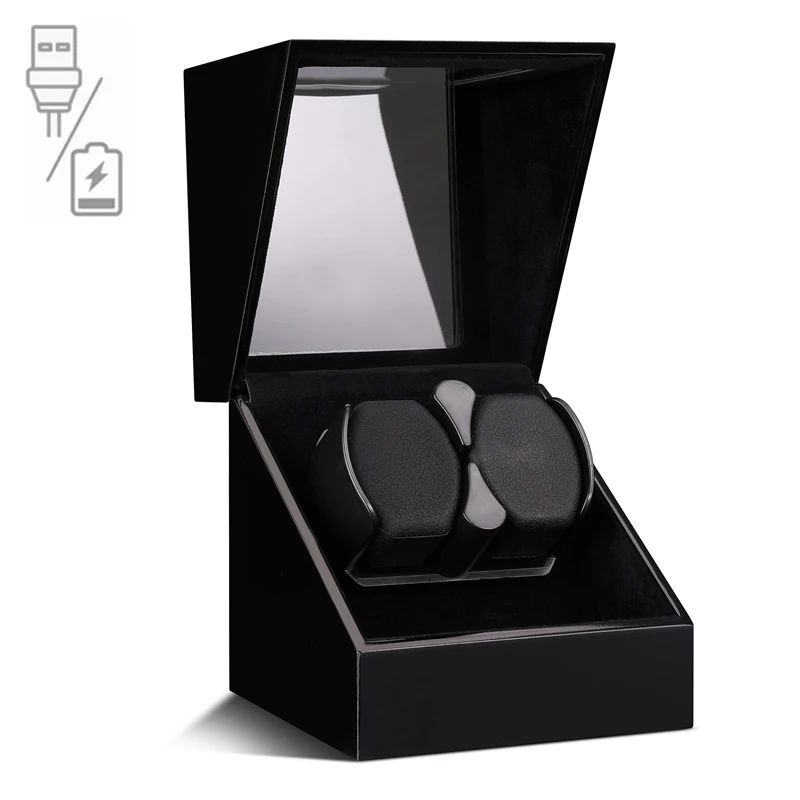
Construction quality significantly impacts both functionality and aesthetics. While basic winders use plastic components, luxury watch winder options typically feature premium materials like hardwood cabinets, metal accents, and tempered glass displays. These not only protect your watches but also showcase them appropriately.
The best winders balance technical capabilities with elegant presentation, offering both proper maintenance for your timepieces and an attractive display that complements your collection.
Automatic Watch Winder, Luxury Watch Winder, Single Watch Box
$307.39 Select options This product has multiple variants. The options may be chosen on the product page4 Watch Winder, 6 Watch Box, Automatic Watch Winder
$512.31 Select options This product has multiple variants. The options may be chosen on the product pageAutomatic Watch Winder, Single Watch Winder, Wooden Watch Holder
$201.76 Select options This product has multiple variants. The options may be chosen on the product pageAutomatic Watch Winder, Leather Watch Travel Case, Single Watch Winder
$146.30 Select options This product has multiple variants. The options may be chosen on the product pageAutomatic Watch Winder, Double Watch Winder, Leather Watch Boxes
$147.60 Select options This product has multiple variants. The options may be chosen on the product pageAutomatic Watch Winder, Double Watch Winder
$206.18 Select options This product has multiple variants. The options may be chosen on the product page
Specialized Winding Considerations for Complex Watches
Certain sophisticated timepieces require special attention when it comes to winder settings:
Perpetual Calendar Watches
Special Consideration: These complex watches track months, years, and leap years automatically—but only if they remain running.
Perpetual calendar mechanisms are among the most sophisticated complications in watchmaking. If these watches stop, resetting the calendar functions can be complicated and often requires a trip to a watchmaker. For perpetual calendars, consistent winding is essential. Many experts recommend:
– Slightly higher TPD settings to ensure continuous operation
– Bi-directional winding to maximize power transfer
– Using winders with battery backup to protect against power outages
Moon Phase Displays
Watches with moon phase complications track the lunar cycle through a specialized disc display. When these watches stop, recalibrating the moon phase requires careful adjustment. Similar to perpetual calendars, consistent operation helps maintain accuracy.
Chronograph Movements
While basic chronograph functions don’t typically affect winding requirements, some automatic chronographs have higher power demands due to their complex movement architecture. These watches may benefit from TPD settings in the higher end of the manufacturer’s recommended range.
Vintage Automatic Watches
Timepieces produced before the 1990s often have more delicate winding mechanisms without modern protective features. For these watches:
– Lower TPD settings (500-650) are generally safer
– Direction specifications are particularly important
– Rest periods between winding sessions are beneficial
The best automatic watch winder settings for complex watches often require more research, as these timepieces represent significant investments. When in doubt about specialized watches, consulting with an experienced watchmaker provides valuable guidance tailored to your specific timepiece.
Frequently Asked Questions About Watch Winder Settings
Can I damage my watch with incorrect winder settings?
Modern automatic watches have built-in protection against overwinding, but consistently incorrect settings can cause premature wear. Using extremely high TPD settings or the wrong direction may stress components unnecessarily. Follow manufacturer recommendations whenever possible.
Should I use a winder for all my automatic watches?
Not necessarily. Watches worn regularly (3-4 times weekly) may not need winders. Winders are most valuable for complicated watches (perpetual calendars, moon phases) and timepieces worn less frequently that you want ready to wear without resetting.
How long can I leave my watch on a winder?
Quality automatic watches can remain on properly configured winders indefinitely without harm. However, all mechanical watches benefit from regular service every 3-5 years regardless of winder use.
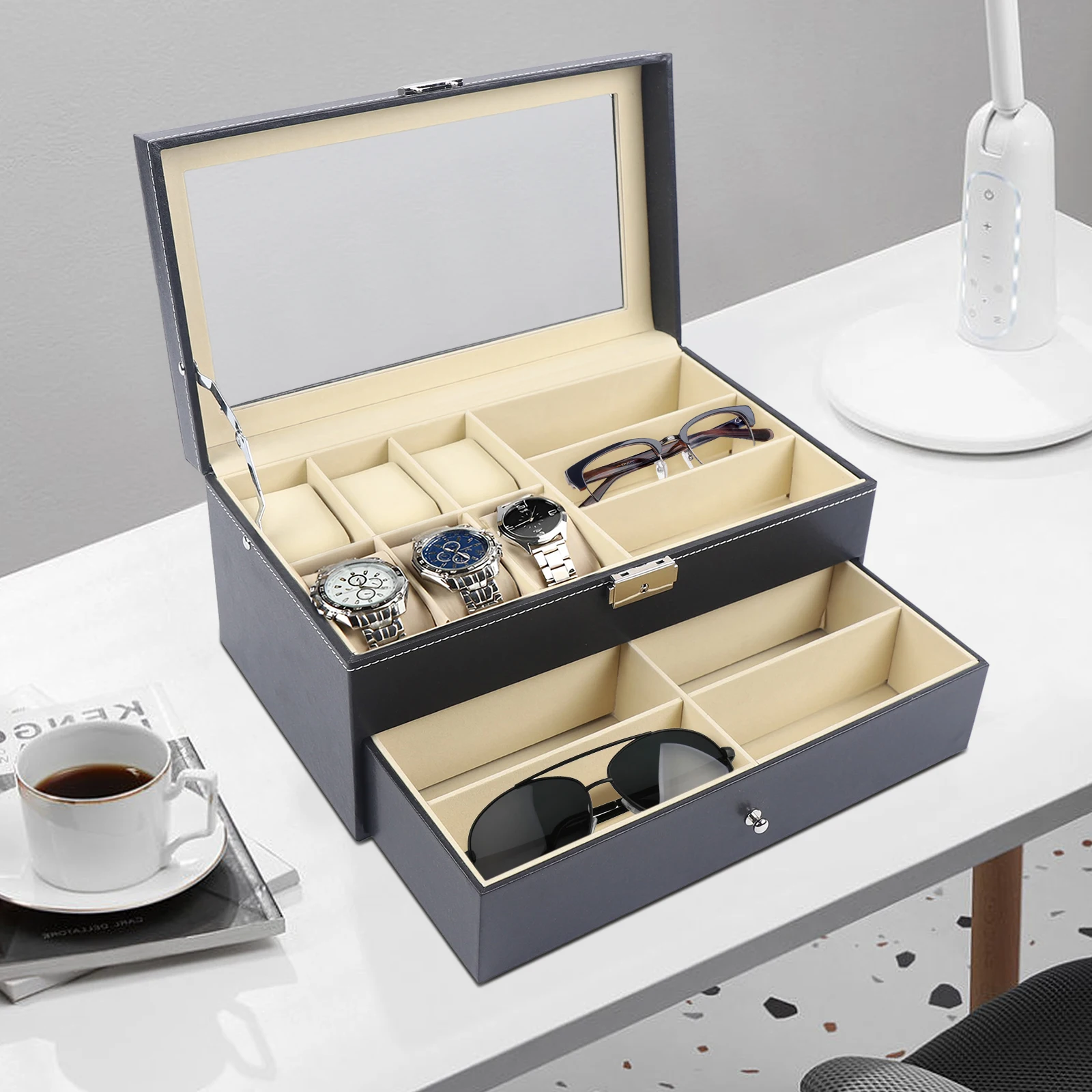
Are watch winders necessary for automatic watches?
Not strictly necessary, but highly convenient. Without winders, automatic watches will stop when their power reserve depletes (typically 38-48 hours after last wear). Winders eliminate the need to reset the time and date each time you wear the watch.
Do watch winders wear out watch movements faster?
When used with correct settings, winders should not significantly impact movement longevity. In fact, keeping the lubricants in motion can actually benefit watch movements, as static oils can congeal over time.
Can I use one setting for all my watches?
Using a single single watch winder with universal settings is not ideal. Different watches have different winding requirements. Multi-watch winders with individually programmable settings provide the best care for varied collections.
Conclusion: Ensuring Your Automatic Watches Remain Ready to Wear
After exploring the complexities of watch winder settings, one thing remains clear: there is no universal “best” direction that works for all timepieces. The optimal configuration depends entirely on your specific watch’s movement design.
Proper research into your watch’s TPD and directional requirements represents an investment in protecting your timepiece. By taking the time to determine the correct settings—whether through manufacturer documentation, online databases, or careful testing—you ensure your automatic watches receive exactly the care they need.
Remember that correctly configured watch winders serve two important purposes: they keep your watches ready to wear at a moment’s notice, and they help maintain the mechanical components in optimal condition. The small effort required to set up your winder properly pays dividends in both convenience and the long-term health of your cherished timepieces.
For collectors with multiple watches, considering winders with individual adjusting watch winder movements capabilities ensures each timepiece receives precisely tailored care. This attention to detail reflects the same craftsmanship and precision that makes automatic watches so special in our increasingly digital world.



